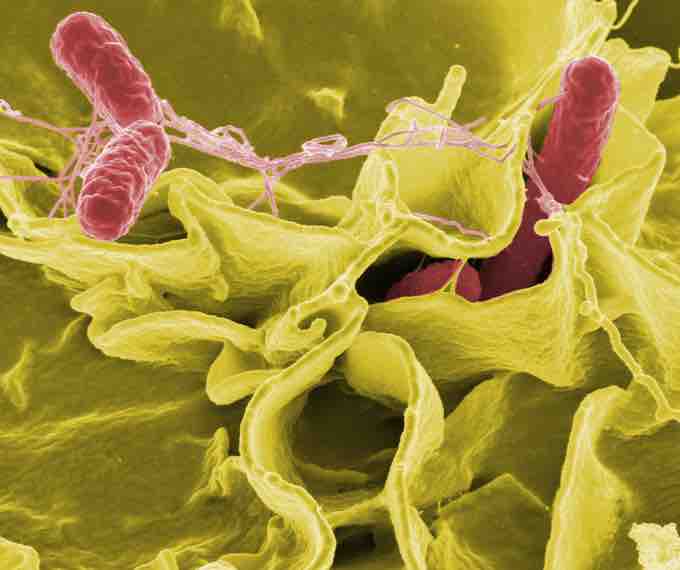Salmonellosis is an infection with the Salmonella bacteria . Most people infected with Salmonella develop diarrhea, fever, vomiting, and abdominal cramps 12 to 72 hours after infection. In most cases, the illness lasts four to seven days, and most people recover without treatment. However, in some cases the diarrhea may be so severe that the patient becomes dangerously dehydrated and must be taken to a hospital. At the hospital, the patient may receive intravenous fluids to treat the dehydration, and may be given medications to relieve symptoms, such as fever reducers. In severe cases, the Salmonella infection may spread from the intestines to the bloodstream, and then to other body sites, and can cause death unless the person is promptly treated with antibiotics. The elderly, infants, and those with impaired immune systems are more likely to develop severe illness. Some people afflicted with Salmonellosis later experience reactive arthritis, which can have long-lasting, disabling effects.

Salmonella
Salmonella is a genus of rod-shaped, gram-negative, non-spore-forming, predominantly motile enterobacteria (shown here in red).
Different Kinds of Salmonella
The different kinds of Salmonella include S. bongori and S. enterica. The type of Salmonella usually associated with infections in humans, nontyphoidal Salmonella, is usually contracted from: poultry, pork, and beef when the meat is prepared incorrectly or is infected with the bacteria after preparation; infected eggs, egg products, and milk when not prepared, handled, or refrigerated properly; reptiles (such as turtles, lizards, and snakes) which can carry the bacteria in their intestines; and tainted fruits and vegetables.
The typhoidal form of Salmonella can lead to typhoid fever. Typhoid fever is a life-threatening illness, and about four hundred cases are reported in the United States each year, with 75% of those acquired while traveling out of the country. It is carried only by humans and is usually contracted through direct contact with the fecal matter of an infected person. Typhoidal Salmonella is more commonly found in poorer countries, where unsanitary conditions are more likely to occur, and can affect as many as 21.5 million people a year.
Salmonella Infection
The Salmonella bacterium induces responses in the animal it is infecting, and this is what typically causes the symptoms rather than any direct toxin that is produced. Symptoms are usually gastrointestinal, including nausea, vomiting, abdominal cramps, and bloody diarrhea with mucus. Headache, fatigue, and rose spots are also possible. These symptoms can be severe, especially in young children and the elderly. Symptoms last generally up to a week, and can appear 12 to 72 hours after ingesting the bacterium. After bacterial infections, reactive arthritis (Reiter's syndrome) can develop.
An infectious process can only begin after living salmonellae (not only their toxins) reach the gastrointestinal tract. Some of the microorganisms are killed in the stomach, while the surviving salmonellae enter the small intestine and multiply in tissues (this is the localized form). By the end of the incubation period, the macro-organisms are poisoned by endotoxins that are released from the dead salmonellae. The local response to the endotoxins is enteritis and gastrointestinal disorder. In the generalized form of the disease, salmonellae pass through the lymphatic system of the intestine into the blood of the patients (typhoid form) and are carried to various organs (liver, spleen, kidneys) to form secondary foci (septic form).
Endotoxins first act on affected organs' vascular and nervous systems, manifested by: increased permeability and decreased tone of the vessels, upset thermal regulation, vomiting, and diarrhea. In severe forms of the disease, enough liquid and electrolytes are lost to upset the body's metabolism of water and salt, decreasing the circulating blood volume and arterial pressure to enough of a degree to cause hypovolemic shock. Septic shock may also develop. Shock of mixed character (with signs of both hypovolemic and septic shock) is more common in severe salmonellosis. Oliguria and azotemia develop in severe cases as a result of kidney involvement due to hypoxia and bacteremia.